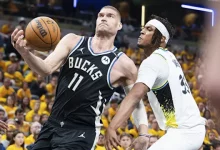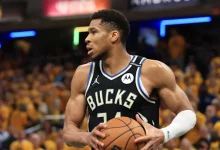Because of his performance and potential, Jonny Brodzinski has become a headache for the New York Rangers, making roster decisions more difficult.

When a player like Jonny Brodzinski begins to make waves with his performance, it can create more than just excitement for a team. It can also lead to difficult decisions that require careful consideration. For the New York Rangers, Brodzinski’s rise has created a problem, albeit a good one – a “Jonny Brodzinski problem.” His performance and potential are forcing the Rangers to reevaluate their roster, and in a salary-cap league like the NHL, this kind of situation can lead to difficult decisions, as the team tries to balance its lineup and make the most of its cap space.
Brodzinski, a forward who has shown flashes of brilliance during his time with the Rangers, represents a complex puzzle for the team’s management and coaching staff. His work ethic, skill set, and ability to step up when called upon have earned him a place on the radar of both coaches and fans. Yet, as a player who is constantly striving to secure his spot in an already competitive lineup, his emergence has added an additional layer of complexity to the Rangers’ roster decisions. His performance could push the Rangers to address depth issues in new ways, and his potential could prompt them to make some uncomfortable choices.
In this article, we’ll take a deeper look at Jonny Brodzinski’s journey with the New York Rangers, explore why his rise has led to difficult roster decisions, and discuss the implications of his continued success for the team’s future.
Jonny Brodzinski: The Path to the NHL
Jonny Brodzinski’s career didn’t begin with high expectations. Drafted in the 5th round (148th overall) of the 2013 NHL Draft by the Los Angeles Kings, Brodzinski’s development was steady, but he wasn’t considered a top prospect. His journey took him through various stages of minor league hockey, where he developed his game and tried to prove he could be more than just a depth player.
Brodzinski spent a considerable amount of time in the American Hockey League (AHL) with the Manchester Monarchs, Ontario Reign, and later the San Jose Barracuda. His ability to play in all situations, his defensive responsibility, and his scoring touch in the AHL demonstrated that he had the tools to be an effective NHL player. His numbers in the minors were respectable, and his performance didn’t go unnoticed by NHL scouts.
Brodzinski finally made his NHL debut with the Los Angeles Kings in 2016. While his appearances were brief, they provided a glimpse of his potential. Over time, Brodzinski became more accustomed to the NHL’s speed and physicality, and he slowly carved out a niche as a bottom-six forward. However, after several seasons with the Kings, Brodzinski bounced around between different teams and the AHL, with short stints in the NHL. His development appeared to plateau, and it wasn’t until his time with the Rangers that Brodzinski began to show the kind of potential that would make him a key contributor to the team.
The Rangers Take a Chance on Brodzinski
In 2022, Brodzinski was claimed off waivers by the New York Rangers from the San Jose Sharks, marking a new chapter in his career. The Rangers were in the midst of building a competitive team with the goal of contending for the Stanley Cup. With a solid core of stars like Artemi Panarin, Mika Zibanejad, and Igor Shesterkin, the Rangers’ roster was already built for success, but they still needed depth players to fill out the lineup. Brodzinski, who was still fighting for regular NHL ice time, seemed like a player who could be a solid contributor in a depth role, particularly as a versatile forward who could play both center and wing.
Brodzinski’s arrival in New York was met with cautious optimism. The Rangers knew that while he was not a game-breaker, he had the potential to contribute in a meaningful way. His leadership qualities, along with his versatility and defensive responsibility, gave him a chance to earn a regular spot in the lineup. The Rangers’ coaching staff, led by Gerard Gallant, believed that with the right opportunity, Brodzinski could make an impact.
Sure enough, Brodzinski’s play began to catch the attention of the Rangers’ brass. He showed a level of consistency and a willingness to do the little things right, whether it was playing on the penalty kill, winning key faceoffs, or being a reliable presence in the bottom-six forward group. His tenacity and ability to bring energy to the ice made him a player the Rangers could rely on, especially in games where depth contributions were needed.
The Jonny Brodzinski Problem: Performance and Potential
As Brodzinski’s play continued to improve, his role within the team expanded. He became a reliable depth player for the Rangers and earned the trust of Gallant, who began to give him more opportunities in key situations. However, as his performance began to stand out, it created what could be called a “Jonny Brodzinski problem” for the Rangers. While Brodzinski was doing everything in his power to prove he belonged in the lineup, his growing impact on the team made it difficult for the Rangers to make roster decisions.
Depth and Cap Space Issues
The most immediate challenge created by Brodzinski’s improved play was the financial implications it had on the Rangers’ cap space. NHL teams must carefully manage their rosters, especially in a salary cap environment, where every dollar counts. The Rangers were already dealing with significant cap constraints, and as Brodzinski started to show that he could contribute at a higher level, the team had to consider how to balance its roster with limited financial flexibility.
If Brodzinski’s performance continued to improve, he would likely warrant a bigger role within the team. This would lead to increased salary demands and the need to re-evaluate the team’s cap situation. A player in Brodzinski’s position, who is pushing for more ice time and a larger role, could end up taking away opportunities from others in the organization or force the Rangers to make difficult decisions regarding which players to keep and which players to move. In the tight salary cap world of the NHL, such decisions can lead to tough tradeoffs.
The Competition for Roles
Brodzinski’s success has also made it increasingly difficult for the Rangers to find space for all their players. With a loaded roster that features numerous talented forwards, Brodzinski’s rise adds pressure to the team’s bottom-six forwards. The Rangers’ forward group is full of players who can play versatile roles, but with Brodzinski playing at a higher level than expected, it forces the team to make tough calls on who stays in the lineup and who sits out.
There are players on the roster who might feel that they deserve those ice-time opportunities over Brodzinski, and the competition within the team can lead to tension, or at the very least, difficult conversations. Should the Rangers stick with their established depth players, or should they go with the hot hand in Brodzinski? If he continues to show that he can perform at a high level, his presence will force the Rangers’ coaches and general managers to reassess how they want to structure the lineup.
Long-Term Potential
One of the key factors that make Brodzinski such a difficult player to move or bench is his long-term potential. As a player who’s proven he can contribute in the NHL, Brodzinski has a future with the Rangers that could extend beyond the current season. He’s a reliable, versatile player who can move up and down the lineup, and he provides the kind of depth that playoff teams need.
Given that the Rangers are in a championship window, with the likes of Panarin, Zibanejad, and Shesterkin leading the charge, it’s crucial to have depth players who can contribute in all situations. Brodzinski, with his ability to perform in high-pressure moments, could become an even more important piece as the Rangers continue to push for a Stanley Cup. However, his growing role means that the Rangers have to carefully balance their roster for both short-term and long-term goals.
Managing the Brodzinski Dilemma: What the Rangers Must Do
As the Rangers work to solve the Brodzinski problem, there are several strategies they can consider to manage the situation effectively.
1. Keeping Brodzinski in the Lineup
The simplest option might be to keep Brodzinski in the lineup and continue giving him opportunities to grow. His energy, leadership, and versatility are valuable assets, especially for a team that has serious playoff aspirations. Keeping him in the lineup allows the Rangers to tap into his potential and provides depth when injuries or other issues arise. While this option may require managing cap space and potentially making trades, it also gives the Rangers the ability to keep their lineup fluid and adaptable to changing circumstances.
2. Trading for Cap Flexibility
If Brodzinski’s role continues to grow and his salary demands increase, the Rangers may need to explore trading other players to create cap space. The Rangers could look to move depth players or assets that are expendable, all while maintaining their core group of stars. This would give Brodzinski the opportunity to continue to develop in a more prominent role without significantly impacting the Rangers’ overall team composition. A trade could also give the Rangers an opportunity to improve other areas of their roster, such as adding more scoring depth or bolstering their defense.
3. Strategic Roster Adjustments
Another approach the Rangers could take is to make strategic adjustments to their roster by rotating players in and out of the lineup, ensuring that Brodzinski remains engaged and continues to develop while maintaining balance. This could involve giving him more ice time on specific game nights or allowing him to step up in key moments. By doing so, the Rangers can continue to evaluate his potential while keeping the rest of the roster fresh.









